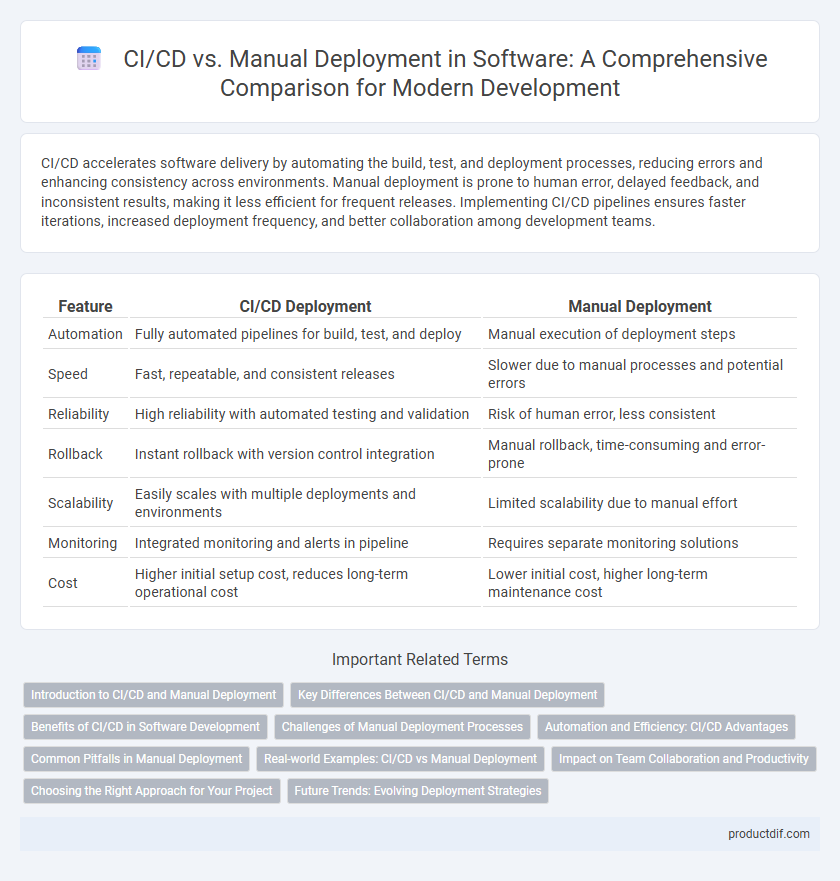CI/CD accelerates software delivery by automating the build, test, and deployment processes, reducing errors and enhancing consistency across environments. Manual deployment is prone to human error, delayed feedback, and inconsistent results, making it less efficient for frequent releases. Implementing CI/CD pipelines ensures faster iterations, increased deployment frequency, and better collaboration among development teams.
Table of Comparison
| Feature | CI/CD Deployment | Manual Deployment |
|---|---|---|
| Automation | Fully automated pipelines for build, test, and deploy | Manual execution of deployment steps |
| Speed | Fast, repeatable, and consistent releases | Slower due to manual processes and potential errors |
| Reliability | High reliability with automated testing and validation | Risk of human error, less consistent |
| Rollback | Instant rollback with version control integration | Manual rollback, time-consuming and error-prone |
| Scalability | Easily scales with multiple deployments and environments | Limited scalability due to manual effort |
| Monitoring | Integrated monitoring and alerts in pipeline | Requires separate monitoring solutions |
| Cost | Higher initial setup cost, reduces long-term operational cost | Lower initial cost, higher long-term maintenance cost |
Introduction to CI/CD and Manual Deployment
CI/CD (Continuous Integration and Continuous Deployment) automates the software release process, enabling faster and more reliable code integration and delivery through automated testing and deployment pipelines. Manual deployment involves human intervention to transfer code to production environments, which can increase the risk of errors and slow down release cycles due to repetitive tasks. Organizations adopting CI/CD benefit from improved consistency, scalability, and reduced deployment time compared to traditional manual deployment methods.
Key Differences Between CI/CD and Manual Deployment
CI/CD automates the build, test, and deployment processes, enabling faster and more reliable releases compared to Manual Deployment, which relies on human intervention and is prone to errors. Continuous Integration integrates code changes frequently, while Continuous Delivery ensures the software is always in a deployable state, contrasting with Manual Deployment's sporadic and slower release cycles. Metrics such as deployment frequency, lead time for changes, and failure recovery rates highlight the superior efficiency and consistency of CI/CD pipelines over Manual approaches.
Benefits of CI/CD in Software Development
CI/CD pipelines automate the software deployment process, significantly reducing human error and increasing delivery speed. This approach enhances code quality through continuous testing and integration, enabling faster feedback and quicker identification of defects. By streamlining releases, teams achieve more reliable updates and improved collaboration across development and operations.
Challenges of Manual Deployment Processes
Manual deployment processes often lead to inconsistent application releases due to human error and lack of standardized procedures. These challenges include prolonged deployment times, difficulty in tracking changes, and increased risks of downtime or rollback failures. The absence of automation hinders scalability and disrupts continuous integration and delivery pipelines, impacting overall software quality and team productivity.
Automation and Efficiency: CI/CD Advantages
CI/CD pipelines automate the software delivery process by integrating continuous integration, continuous testing, and continuous deployment, significantly reducing human error and deployment time. This automation enhances efficiency, ensures consistent builds, and enables rapid feedback loops, which manual deployment cannot reliably achieve. Automated CI/CD workflows accelerate release cycles, improve code quality through frequent testing, and allow teams to focus on innovation rather than repetitive deployment tasks.
Common Pitfalls in Manual Deployment
Manual deployment in software development often leads to human errors such as misconfigurations, version inconsistencies, and incomplete updates, which can cause system downtime or bugs. Lack of standardized processes increases deployment time and reduces repeatability, resulting in inefficient collaboration and delayed releases. Automated CI/CD pipelines minimize these risks by enforcing consistency, ensuring comprehensive testing, and accelerating delivery cycles.
Real-world Examples: CI/CD vs Manual Deployment
CI/CD pipelines significantly reduce deployment errors and accelerate release cycles, as demonstrated by companies like Netflix, which deploys thousands of times per day using automated workflows. In contrast, manual deployment processes at smaller startups often lead to slower updates and higher risks of human error, impacting product stability. Real-world comparisons reveal that CI/CD enables continuous integration and delivery, improving software quality and operational efficiency compared to traditional manual methods.
Impact on Team Collaboration and Productivity
CI/CD automates the deployment process, reducing human error and accelerating release cycles, which significantly enhances team collaboration by enabling more frequent and reliable updates. Manual deployment often causes delays and inconsistencies, leading to communication bottlenecks and decreased productivity within development and operations teams. Implementing CI/CD pipelines fosters continuous feedback and streamlined workflows, resulting in higher efficiency and improved coordination across the software development lifecycle.
Choosing the Right Approach for Your Project
CI/CD pipelines automate software integration and delivery, reducing human error and accelerating release cycles, making them ideal for projects requiring frequent updates and robust testing. Manual deployment may suit smaller projects or those with infrequent updates, offering greater control but increasing the risk of inconsistencies and longer release times. Evaluating project size, complexity, team expertise, and the need for scalability is crucial when choosing between CI/CD and manual deployment strategies.
Future Trends: Evolving Deployment Strategies
CI/CD pipelines are increasingly integrated with artificial intelligence and machine learning to automate deployment processes, enhancing accuracy and reducing downtime. Manual deployment is gradually becoming obsolete as organizations adopt containerization and orchestration tools like Kubernetes for scalable, flexible release management. Future deployment strategies emphasize continuous monitoring, real-time feedback loops, and security automation to meet the demands of rapid software delivery and evolving infrastructure.
CI/CD vs Manual Deployment Infographic

 productdif.com
productdif.com